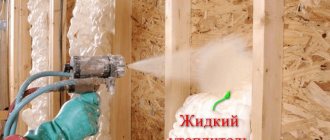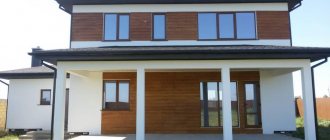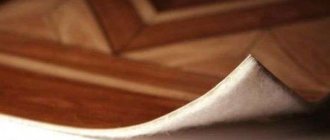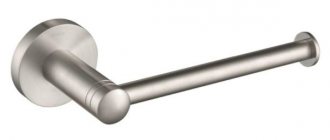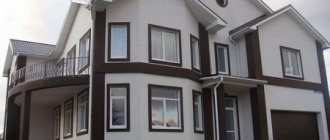Over the past couple of decades, the requirements for building materials regarding their thermal conductivity and insulation abilities have increased significantly. The growing cost of thermal energy, for which you need to pay the market price, forces you to re-arrange thermal insulation even for previously built buildings. We’ll talk about one such technology – heat-insulating plaster (or, more simply, warm plaster) below.
Despite the fact that warm plaster is also used for interior work, it is most often used outside, which imposes a number of restrictions on this material. This information material will be devoted to the composition of the mixture, the nuances of its use, as well as specific brands present on the market.
Insulating plaster – what is it?
Let's look at what warm plaster is. Everyone has long been accustomed to the fact that the classic plaster mixture is a cement-sand mortar containing certain additives. The latter can be lime (to prevent the walls from becoming damp) or all kinds of polymer adhesives (for better adhesion) or even dyes. But what is the mixture for insulating plaster?
In fact, everything is very simple: a filler with a thermal conductivity coefficient significantly lower than that of hardened cement mortar is added to the usual cement-sand mixture (which may also include other polymer components).
Such additives may include:
- expanded vermiculite;
- expanded clay;
- volcanic pumice chips;
- sawdust;
- polystyrene foam granules.
In essence, warm plaster is the same classic plaster mixture that has long been used for finishing buildings and structures, only with additional inexpensive “insulating” components.
Let's sum it up
Warm plaster is used as a leveling building material, similar to its conventional counterparts. The mixtures are also used for treating facades and walls indoors with any humidity. A characteristic feature of this plaster is its heat-insulating property, along with which the coating does not allow noise to pass through.
The affordable cost of warm plaster and a wide range of applications have a clear advantage over analogues. In addition, you can prepare warm plaster with your own hands .
Advantages and disadvantages of warm plasters
New properties are added to the familiar material, and since the laying technology has long been proven and is as cheap as possible, the use of such plaster for thermal insulation of buildings provides considerable economic benefits. And this is the first significant advantage of heat-insulating plaster.
The second interesting quality of this material is that such plaster can be used not only as insulation, but also as a humidity normalizer in the room. Some components (for example, sawdust) are able to absorb excess moisture in the air and release it at a reduced concentration of moisture vapor in the atmosphere. And, in addition, warm plaster is an excellent insulator from moisture, protecting capital structures from its effects.
Thirdly, you can easily make a mixture for warm plaster yourself - for this you just need to have the necessary components on hand.
Let us briefly list other useful properties of warm plasters:
- wear resistance;
- environmental safety and cleanliness;
- resistance to temperature changes;
- due to its high adhesive properties, warm plaster can be applied to almost any surface;
- the array forms a single, integral layer, which practically does not require a reinforcing mesh.
However, to be completely objective, it is worth mentioning the disadvantages of thermal insulating plasters. Compared to specialized insulating materials (for example, mineral wool), warm plaster, no matter what it contains as an insulating component, loses by a noticeable margin. To provide the same level of insulation as a stone wool slab, the layer of warm plaster must be twice as thick.
This is why many people call warm plaster a “half solution.” However, if we take into account its economic benefits and technological simplicity, then such a solution may often be quite sufficient.
Reinforcing layer
After preparation, you can proceed to plastering the reinforcing layer. Often, plaster alone is not enough to level out detected differences; then a reinforcing mesh is required. It strengthens and fastens the plastered surface, significantly increasing the permissible dimensions of the layer thickness. Although manufacturers claim that plaster does not need to be reinforced with reinforcing mesh, it is better to consult with knowledgeable people before making a final decision.
With reinforcement
Varieties by composition
There are 2 types of heat-insulating plaster mixtures:
- Warm cement plaster. This includes all of the above cement-containing mixtures with the specified additives.
- Foamed plaster. A component is added to the cement-containing mixture that causes the formation of foam when interacting with water. The structure of the solution in this case will be similar to foam concrete in both its raw and hardened form. This type of plaster has significantly higher thermal insulation properties, but it requires mandatory subsequent processing - painting, since the porous structure, like a sponge, can effectively absorb moisture.
What mixtures are on sale?
This material has been used in construction relatively recently, but due to its properties it is gaining more and more popularity every year. The most famous brands:
- Unis Teplon white and gray - gypsum heat-saving plaster with perlite filler. Designed for interior decoration of walls and ceilings in rooms with normal humidity. It has good vapor permeability, so it maintains a comfortable microclimate in the house. Eunice Teplon can serve as a base for wallpaper, tiles or paint. Instructions and characteristics.
- Knauf Grünband is an insulating cement plaster with expanded polystyrene and hydrophobic additives. Suitable for aerated concrete, concrete, brick and ready for any subsequent finishing. Used for plastering walls outside and inside the house. The finely dispersed structure of the mixture allows it to be formed into dense solutions that are easily applied both manually and by machine.
- Ivsil : high-quality and relatively inexpensive plaster Ivsil Thermosil with penostek foam glass is used for thermal and sound insulation. The binder is cement with polymer additives. Suitable for covering external walls, windows and communications.
- Ecothermogroup : Umka thermal insulation mixtures have good heat and sound insulation properties. The composition includes: binders (cement, lime), flint filler and polymer modifying additives. Umka is lightweight and sufficiently durable.
- Teplover : produces a cement-lime mixture with the addition of expanded vermiculite and perlite. Like other cement-containing plasters, it is suitable for outdoor use and wet rooms.
- Houncliffe is a heat-saving composition made of cement, lime, composite filler of our own production and polymer binders.
- The bear is now produced under the WarmMix . Foam glass is used as a filler. Features low thermal conductivity (0.065 W/m*K)
- Ceresite CT 24 Light contains perlite, it serves more to lighten the cement mortar. This is primarily a leveling plaster.
Rating of the best
Let's consider several main brands of mixtures for warm plasters:
UMKA® UB-21 TM
Here, ceramic silicon balls are used as a heat-insulating filler. Thanks to the porous structure of this filler, Umka warm plaster provides not only reduced thermal conductivity and a high level of heat conservation, but also high-quality sound insulation. In addition, an array of such plaster has a low specific gravity, due to which it is firmly held on the surface of the capital structure even without a reinforcing mesh.
PALADIUM Palaplaster-207
The sand-cement mixture here contains a special component as a heat-insulating filler - foam glass - a porous but durable filler in the form of granules. It does not contribute to the absorption of moisture vapor from the air, is absolutely “indifferent” to fire, and most importantly, it provides increased heat and sound insulation of the surface of the capital structure.
De Luxe "TEPLOLUX"
The plaster mixture is intended for laying on a concrete base or on foam concrete blocks - it is to these surfaces that the composition demonstrates the maximum degree of adhesion. The mixture contains plaster insulation - 3 mm granules of the same foam concrete (so this property of this plaster mixture is quite understandable).
UNIS TEPLON
This is a variant of gypsum plaster. Gypsum itself is significantly less thermally conductive than solid cement. However, to enhance the thermal insulation properties, perlite (or volcanic glass) granules are added to this mixture.
HAGAst AuBenputzPerlit FS-402
This plaster mixture is based on cement, but also contains perlite, which makes it possible to achieve high sound and heat insulation properties. The mixture is specially intended, mainly for finishing surfaces made of gas and foam concrete.
Knauf Grinband
This thermal plaster contains polystyrene foam granules as an insulating filler, with a fraction of no more than one and a half millimeters. In addition, the mixture contains polymer components that reduce the dispersion of the dried mass and prevent contact of polystyrene granules with moist vapor contained in the atmosphere.
Types of heat-insulating mixtures for plastering
*
Mixtures are divided according to purpose and type of filler used. Plaster for internal use is made on the basis of cement or gypsum and fillers:
- Perlite. The material has a porous structure, formed as a result of the melting of volcanic glass. It is resistant to temperature changes, hygroscopic, and biologically inert.
Perlite filler
- Expanded polystyrene granulate with high thermal insulation properties and low cost.
- Foam glass made from quartz sand. It is moisture resistant, the mixtures are allowed for use in rooms with high humidity.
- Vermiculite obtained from mica. It has high strength and is biologically inert. Not used for finishing rooms with unstable humidity conditions.
- Sawdust. For the production of warm plaster mixtures, only small wood sawing waste is used. They impart porosity to the material and ensure uniformity throughout the entire volume.
- Expanded clay sand. It is characterized by low specific gravity, porosity, and low thermal conductivity.
Expanded clay is one of the popular fillers.
Plaster for external use is made in the same varieties as for finishing inside buildings, but exclusively on a cement base.
Where is plaster used for wall insulation?
Thermal insulating plaster can be used for finishing capital structures both indoors and outdoors. Let's consider some features of both formats of its use.
Interior work
To finish the interior surfaces of a building, as a rule, a not too thick layer of plaster is applied. And it’s not at all a matter of the desire to save the useful volume of the premises; it’s just that plaster to insulate the walls from the inside will prevent the internal heat of the house from penetrating into the walls themselves.
What matters here is the so-called dew point, namely its exact location. At what point on the wall of a building does the temperature drop so much that the moisture in the air condenses? Obviously, if this point (or rather, an entire plane) is located inside the solid wall, then this will lead to its erosion - water is extremely dispersed, and its vapors are able to penetrate into all the pores and microcracks of concrete and cement masses. These vapors should not be allowed to turn into liquid (and then possibly freeze) directly inside the wall.
Previously, this was achieved through excessive heating of houses, associated with large energy losses (houses, like giant air heaters, heated the street). Now, heat consumption has been significantly reduced, and plaster on the insulation of internal walls can leave the outer layers of concrete masses “unarmed” from exposure to cold and moisture. Warm plaster is used to insulate walls from the inside, but mainly for the purpose of creating soundproofing of rooms. In this case, its layer should not exceed 30-35 mm.
For example, in Sweden, at the legislative level, there is a ban on insulating residential buildings from the inside (on the scale of private apartments).
External
But for finishing facades, heat-insulating plaster is used very widely. Here its layer, as a rule, is never less than 50 mm, and often reaches 100 mm.
In this regard, there are 2 main nuances:
- Such a mass of plaster must be laid on a reinforcing mesh.
- Dried plaster on top must be painted to prevent the absorption of atmospheric moisture by heat-insulating, but at the same time dispersed granules and materials.
Work progress
For thermal insulation plaster to be effective, a number of rules must be followed:
- Carry out high-quality surface preparation.
- The consistency of the water in the mixture must correspond to the proportions described in the instructions.
- Dry plaster is poured into poured water and stirred thoroughly for 5 minutes.
- Mixes are made in small portions, which can be completed in a short period of time.
- Finishing work is carried out in the following temperature range – from +5 to +30°C. Wind, raindrops, and direct sunlight are not allowed when plastering the surface.
- Make sure that all electrical points in the finishing area are de-energized.
- All work is carried out in protective clothing and glasses.
- If plastering was carried out on beacons, they must be removed after completion of the work.
- The thermal insulation layer should not exceed 25 mm. If you need to increase the thickness of the applied plaster, do it in stages - layer by layer, until the required dimensions are reached.
Applying a warm layer
How to calculate mixture consumption?
As a rule, each manufacturer indicates on the packaging of the plaster mixture the rate of its consumption in terms of 1 m2 of surface to be finished. But if the mixture for plastering is prepared independently, you should keep in mind the average consumption rate (no matter what component composition we are talking about):
25 kilograms of the finished dry mixture when diluted with water should be enough to finish 1-1.4 m2 of wall surface with a 15 mm layer of thermal plaster.
Varieties and selection criteria
Vermiculite plaster
Insulated plaster is classified according to its composition:
- With vermiculite . The substance consists of rock and has powerful antiseptic properties. Protects against mold and mildew. Can be used inside and outside the building.
- With polystyrene foam . Expanded granules of the substance are added to the dry mixture, increasing the strength and thermal insulation of the plaster.
- With sawdust . Sawdust is mixed with paper and clay. The composition is more often used for outdoor work in dry climates. Constant exposure to moisture leads to rapid wear of the plaster.
- Foam glass . The composition is made from purified, ground glass with the addition of carbon and remelting. After hardening, porous grains are formed, which makes the plaster vapor-permeable, resistant to water and light in weight.
Perlite , an additive often used in agriculture, has interesting properties Creates a porous texture, is resistant to mold and temperature changes, but absorbs moisture.
You need to choose insulated plaster for external and internal work by comparing the operating conditions of the building with the characteristics of the product. Most manufacturers indicate on the packaging at what temperature and humidity the mixture will last longer.
Application technology
Laying a layer of warm plaster is no different from applying traditional plaster. The process consists of 3 parts.
Preparatory stage
At the very beginning, you should prepare the surface. You need to clean it from any dirt, chips, peeling, and fill all cracks with putty. It would be useful to apply a primer layer, which will increase the adhesive ability of the wall.
Preparing the mixture
Each mixture requires its own amount of water for mixing - therefore it is strongly recommended to study the instructions (on the package) before opening it. In addition, some mixtures have a rapid crystallization period after wetting them with water, so you need to be clear about how much time you have for the entire plastering process.
The principle of applying building materials
The plaster material is applied to the wall in layers, each no more than 20 mm thick. In this case, each subsequent layer is applied no earlier than 4 hours after laying the previous one (so that the latter has the opportunity to set).
What is the importance of thermal conductivity of plaster.
Thermal conductivity is the ability of a building material to transfer heat through its mass from hotter areas to cooler ones.
The higher it is, the faster the room cools down. In relation to plaster, this property is not as important as manufacturers convince. The point is in thickness - heat-insulating plaster occupies a small volume, the main load for heat conservation is placed on the material of the supporting structure and insulation.
However, plaster also contributes its share, so it is sometimes used for additional insulation of walls and ceilings.
Thermal insulation plaster is not an independent insulation, but can only serve as an additional energy saving measure.
Thermal conductivity depends on the density of the substance.
How to make warm plaster with your own hands?
One of the advantageous features of the material in question is that you can make warm plaster for interior or exterior finishing work with your own hands. Let's consider several options for preparing a mixture for heat-insulating plaster:
Plaster mixture using perlite:
- 1 part cement;
- 1 part sand;
- 4-5 parts perlite.
It is permissible to use PVA glue, but not more than 1% of the total volume.
Mixture using plasticizers:
- 1 part cement;
- 2 parts sand;
- 4 parts vermiculite (volcanic glass, which plays the role of a heat-insulating filler in the mixture);
- 50 gr. PVA glue onto a bucket of cement (10 kg).
In both cases, water should be added until the required mixture consistency is achieved.
Types and features
Gypsum heat-insulating plaster has minimal resistance to variable humidity. Therefore, it is used only inside dry rooms. Cement is often used as a base, since it copes with changes in operating conditions much better. For façade elements, exactly these compositions are used.
Plaster with thermal insulation additives for external use differs in fillers, which affect the characteristic properties of the mixture:
- Organic ones are represented by expanded polystyrene with a fraction of 1-1.5 mm, which is not very durable. Added to cement and lime compositions. The versatility of warm plaster is limited by its flammability. It is recommended to treat the coating with materials as a finishing decoration.
- Minerals make up for the deficiencies of organic matter. These include: quartz glass is hydro-resistant, does not allow heat to pass through and does not shrink; porous raw materials of volcanic origin : mica vermiculite is not afraid of anything except water; Obsidian perlite needs protection from moisture.
- Sawdust has a long drying time, but is great for working on brick and wood. Among these fillers are used: sawdust, paper.
The latter mixtures usually have cement or clay as a base. Manufacturers recommend using such mixtures for interior work. This is due to the fact that the presence of wind is not allowed during the drying process.
Mineral fillers also include pumice and expanded clay. These materials are inferior to analogues in all respects, therefore they are used extremely rarely.
Useful tips and tricks
When applying the plaster mixture, it is extremely important to observe the temperature regime. The composition of warm plaster, due to the presence of a significant amount of filler in it, is less adhesive than classic plaster.
And you need to pay attention:
- on the atmospheric temperature at which work is carried out;
- on the wall temperature;
- on the temperature of the plaster mixture itself.
The ideal option would be if the surface temperature of the wall being finished and the ambient air temperature coincide, and the temperature of the mixture exceeds them by no more than 10°C.
The mixture for warm plaster has a lower specific gravity than the composition of traditional plaster. Therefore, it is necessary to use reinforcing mesh only if a relatively thick layer of this finishing coating is laid (more than 40 mm). And if the wall is plastered without a mesh, the applied mixture should be leveled relative to the pre-set beacons.
Recommendations for use
When using warm plaster for exterior work, you need to take into account the requirements for surface treatment. First you need to calculate the consumption of the product.
Quantity calculation
Construction mixtures always indicate the approximate consumption of the composition under different application conditions. Averages:
- with a layer thickness of 5 cm - from 18 to 25 kg per 1 m²;
- with a layer of 2.5 cm – 10-14 kg per 1 m² of finished mass.
When choosing a layer thickness, they are often guided by the size of the walls. For example, a house with 50 cm walls requires a layer of 8-10 cm.
Tools and materials
When working with warm plaster, standard tools are required:
- set of spatulas;
- roller or paint brush;
- building level;
- special beacons;
- rule for alignment;
- grater;
- Master OK.
A mixing container and a ladle for water will also be needed when working with plaster.
Application technology
The finished plaster mixture dries quickly, which necessitates the need to prepare small portions. However, you should not rush into application. All manipulations are performed carefully and carefully.
Beacons are used to level the wall. Reinforcing mesh may also be required
Install the beacons vertically along the wall, and then moisten the surface with water and begin distributing the composition:
- Place piles of solution at a distance of 50 cm from each other.
- Due to good adhesion, the putty does not flow down, but is held on the surface. Beacons are embedded in these slides. Their position is adjusted according to the level.
- To stabilize the profile, the void under it along its entire height is filled with a solution using a spatula. Everything must be done very carefully so that the beacon does not go astray. Usually putty edges are formed in front and behind the profile.
- You can maintain a distance of 60 between metal profiles.
Next, they begin to apply the main composition, having previously moistened the wall with water. To do this, use a ladle or spray bottle.- The composition is laid out on the trowel, and then it is applied in a thin layer from bottom to top along the surface of the wall. One layer – up to 1 cm.
- Using the rule, when the area between the beacons is filled, level the surface from bottom to top. Make slight oscillations left and right for better distribution.
- If gaps remain, they are filled with excess solution, removing it from the rule.
- When the layer of plaster hardens a little, it is smoothed by removing the beacon profiles. Metal grooves are filled with plaster and leveled.
Warm plaster granules retain slight porosity. They are filled in after finishing work.
Recommendations from experts
It is convenient to mix the solution with a construction mixer.
The following tips will make working with warm plaster easier:
- if it is difficult to calculate the consumption and proportions, take 0.5 liters of water per 1 kg of dry mixture and prepare in small portions;
- It is more convenient to mix with a drill with a mixer attachment;
- the dry mixture is mixed with water, gradually adding liquid in small portions;
- a trowel and a rule are mandatory tools for application, ensuring evenness of the coating;
- Before trimming excess, you should wait at least 1 hour;
- if the walls are still uneven, you can let them dry completely and apply another layer;
- After drying, the surface is glazed by moistening with water and treating with a sponge grater.
After rough processing, you can rub the walls with a spatula until cement laitance forms.
Reviews
Private reviews regarding the use of warm plaster for interior and exterior work can be found on any Internet portal that has a repair and construction thematic focus. And the best option is to turn to several resources at once (including forum ones). Only in this way can one obtain objective information and form a holistic opinion regarding the qualitative characteristics of a particular type of application of warm plaster in specific conditions.
What does the thermal conductivity of plaster depend on?
Plaster mortar is prepared from a binder (an adhesive substance that can harden when dried) and filler. The thermal characteristics of the mixture depend on the density of the components used in it.
The binder for exterior finishes is cement. Other solutions are used in facade work much less frequently due to their low water resistance. On the contrary, for internal surfaces, solutions with low heat capacity (the ability to accumulate heat) are more often used. These include clay, lime, gypsum.
Sand, marble and glass chips, slag, sawdust, expanded clay, all kinds of extrusions, perlite, vermiculite, foam glass are used as reinforcing and insulating fillers. Their heat transfer capabilities are lower, which makes the usual mixture heat-insulating.
Necessity of calculations
Calculations are an integral part of construction work. They allow you to estimate the necessary costs for materials, calculate the minimum layer thickness, and calculate possible heat losses.
Assessing the effectiveness of thermal insulation
Most building materials are divided into thermal insulation and structural. The former have high thermal conductivity. Used for the construction of walls and ceilings. However, in order to meet the standards and obtain low heat exchange with the environment, the construction of thick walls will be required, which is considered economically ineffective. Therefore, to preserve heat, special heat-insulating materials are used, whose heat conductivity is minimal.
Assessing the effectiveness of thermal insulation is necessary to calculate the need for additional insulation of walls, depending on specific climatic conditions. For each climatic region, standard indicators are calculated depending on temperatures in winter and summer. Calculations are carried out for each element of the structure, taking into account its thickness, material of manufacture and location.
Heat transfer resistance depending on region
If the indicator is within the table values, then additional insulation is not required. If the value is less than the standard value, then a special finishing material with suitable thermal characteristics is selected.
Heat loss
An important point in the calculations is taking into account possible heat losses. Data is required not only when selecting insulation for the facade of a building, but also when designing a heating system, choosing a boiler, purchasing and installing heating radiators.
To calculate, you need to know the locations of the greatest heat loss, as well as the method for calculating the loss.
The main heat output currents include:
- window;
- floor;
- walls;
- ventilation;
- roof.
Main types of heat losses
Depending on the specific element of the room, the amount of heat loss will differ. For walls and ventilation it is 20-30%, for floors and roofs within 10-20%, for windows it can reach 25% depending on the number of double-glazed windows.
When calculating, it is necessary to know the area of the structure, thermal resistance and climatic conditions of the region. Beginners are recommended to use a special calculator that makes the necessary calculations. The total area of structures that come into contact with the cold air flow is taken into account.
A special calculator will help you calculate the heat losses of a building or individual room
The obtained value allows you to design the heating so that losses are compensated.
Walls, floors, and ceilings are made of materials with different performance characteristics. Knowledge and ability to calculate thermal conductivity and heat loss when communicating with the external environment make it possible to select suitable finishing materials and create the most energy-efficient room.
Heat transfer resistance
Heat transfer resistance is the reciprocal of the thermal conductivity coefficient.
The advantage of this parameter is that its value gives an estimate taking into account the thickness of the material and design features. The walls in the building are multi-layered. The base is the base on which leveling layers are applied. Plaster has thermal insulation characteristics that significantly increase the value of thermal resistance.
Each layer in the finish will have its own heat transfer resistance value. To obtain the final value, all resistances are summed up.
The thermal insulation characteristics of the plaster mixture increase the thermal resistance value
If there are air layers in the finishing that do not communicate with the external environment, then the thermal conductivity of such structures will be significantly lower.
Thermal insulating plaster for external use.
External wall insulation is more effective than internal insulation. According to the first scheme, heat is retained and accumulated inside the wall array. In the second, the wall is not protected, the thermal energy is evaporated.
Thermal insulating external façade plaster must have not only low thermal conductivity, but also sufficient moisture resistance. It’s not just about the safety and durability of the layer. Wet insulation conducts heat better. When the water in the thickness of the layer turns into ice, the insulation itself becomes a source of cold.
Wet insulation, including exterior plaster finishes, is much less protective of a home. When freezing, it cools the walls, impedes the movement of steam and quickly collapses.
Non-waterproof plaster coatings used for external thermal insulation plaster must be protected by curtain walls. Ventilated canopy structures are the most rational.
Plaster "Knauf"
Dry mixture "Knauf" is a very expensive finishing material that has good thermal insulation and water-repellent properties. Safe insulation, easy to apply to prepared substrate. Its advantages include vapor permeability, weather resistance, absolute environmental friendliness and additional surface insulation.
Knauf plaster is the best option for interior finishing work.
Reviews of this brand of plaster confirm the manufacturer’s words. According to consumers, the dry mixture is easy to mix, apply to the surface and has good adhesion. The plaster dries quite quickly, which is more of an advantage than a disadvantage. The finished coating has a pleasant beige-pink tint.
Thermal insulating plaster for interior work.
Internal insulation is ineffective, since plaster is not able to protect the house from the cold. And walls without additional insulation quickly cool down.
To include them in the thermal resistance design, it is more rational to take the insulating layer outside.
However, heat-saving plaster for interior work will not be superfluous. Here it is advisable to consider it as a “repeller” of heat. So that thermal energy is not absorbed by the interior decoration.
For such layers, mixtures with a minimum heat absorption rate are used. So that when leaning against the wall, residents do not feel the unpleasant cold. This happens, for example, when plastering with cement compounds.
But the amount of absorption loses significance when the walls are subsequently decorated with vinyl wallpaper, clapboard or plastic. There is no point in internal insulation of a tiled wall (except when they are heated with electric IR films).

